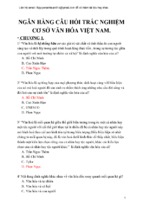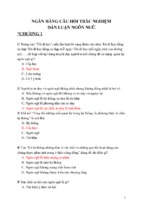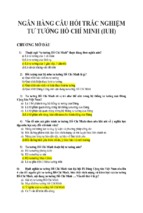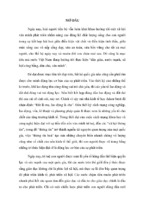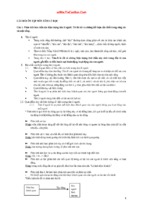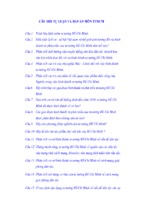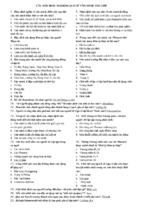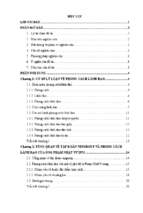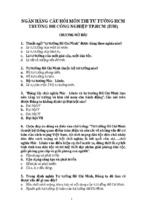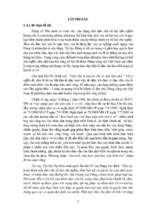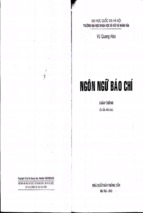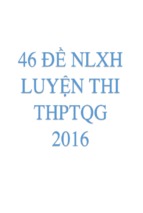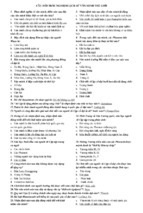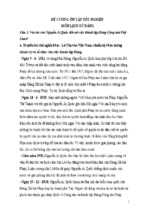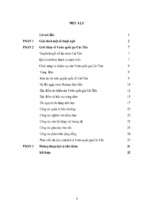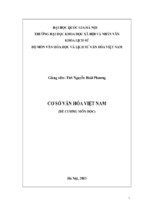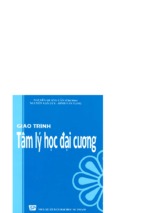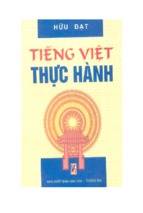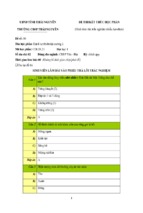MINISTRY OF EDUCATION AND TRAINING
HA NOI NATIONAL UNIVERSITY OF EDUCATION
HOANG THI THANH GIANG
INTEGRATED TEACHING IN GEOGRAPHY 9
IN SECONDARY SCHOOL
Major: Theory and Methodology in Geography
Code: 9.14.01.11
SUMMARY OF DOCTORAL THESIS IN EDUCATIONAL SCIENCES
HA NOI - 2019
The study is completed at Hanoi National University of Education
Advisor (s): 1. Assoc.Prof.Ph.D. Kieu Van Hoan
2. Assoc.Prof.Ph.D. Lam Quang Doc
Reviewer 1: 1. Assoc.Prof.Ph.D. Đo Vu Son
Office: Thai Nguyen University of Education
Reviewer 2: 1. Prof.Ph.D. Nguyen Viet Thinh
Office:Hanoi National University of Education
Reviewer 3: 1. Assoc.Prof.Ph.D. Đo Thuy Mui
Office: Hanoi Pedagogical University of Education 2
The dissertation is defended at Hanoi National University of Education.
At........................., date............ Month ................ 2020
This thesis can be found at:
- National Library of Viet Nam
- Library of Hanoi National University of Education
- Library of Faculty of Geography - HNUE
LIST OF PUBLISHED SCIENTIFIC WORKS
RELATING TO THE THESIS PROTOCOL
Hoang Thi Thanh Giang (2016), “Integrating historical content in teaching
Geography at high school”, Educational Equipment Journal, No. 119, July.
2. Hoang Thi Thanh Giang (2016), “Integrating life skills education for
students in teaching Geography 10 - High School”, Proceedings of the
workshop on Geography Science in the cause of education and training
and socio-economic development of the country.
3. Hoang Thi Thanh Giang – Nguyen Thi Hue (2016), “The importance of
integrating the content of "Green Economy" in teaching Geography in high
school”, Proceedings of the 9th National Geographic Workshop / December.
4. Nguyen Thi Hue - Hoang Thi Thanh Giang, “Integrating climate change
education in geography teaching for high school students oriented to approach
capacity”, Proceedings of the 9th National Geographic Conference / December.
5. Hoang Thi Thanh Giang (2017), “Some issues in developing integrated
teaching capacity for students majoring in Geography at Northwest
University”, Journal of Teaching and Learning today, number of months 6.
6. Hoang Thi Thanh Giang, “Studying solutions to develop integrated
teaching capacity for students in the pedagogical field of Northwestern
University”, research topic at the grassroots level, 2016-2017.
7. Hoang Thi Thanh Giang (2017), “Measures to develop integrated teaching
capacity for students in the pedagogical field of Northwestern University”,
Scientific Journal of Northwest University, No. 11 (12/2017)
8. Hoang Thi Thanh Giang (2018), “Requirements and principles of
organizing theme teaching integrated sustainable development in the
Mekong Delta in Geography - Secondary school”, Proceedings of the 10th
National Conference on Geography.
9. Hoang Thi Thanh Giang – Le Thi Dung (2019), “Organize teaching the topic
of labor - employment and quality of life in teaching Geography 9 in secondary
schools”, Proceedings of the 11th National Geographic Conference.
10. Hoang Thi Thanh Giang – Nguyen Thi Hue (2019), “Applying project
method in teaching integrated subject Geography 9”, Proceedings of the 11th
National Geographic Conference.
11. Hoang Thi Thanh Giang (2019), “Current status of teaching subject
integrated interdisciplinary subject in teaching Grade 9 Geography at
secondary school”, Scientific journal of Hanoi National University of
Education, No. 1.
12. Hoang Thi Thanh Giang – Nguyen Thu Hue (2020), "Enhancing the
application of information and communication technology in integrated
teaching of 9th grade Geography at secondary school", Journal of
Educational Equipments No. 216, term 1, p.7-9.
1.
`
1
INTRODUCTION
1. Urgency of the topic
- The rapid development of science, technology and technology, the
knowledge of humanity requires general education to be fundamental and
comprehensive innovation. Teachers must teach how to integrate science, teach
students how to collect, select, process information, especially know how to
apply the knowledge learned in dealing with real life situations. sacrifice.
- Integration is one of the educational perspectives that has become a
trend in the development of general education programs in many countries
around the world, towards the development of learners' capacity, linking
intellectual activities with practical and practical activities; making learning
more meaningful than studying subjects in a single way. Geography as an
interdisciplinary science, has an advantage in integrated teaching, both internal
and interdisciplinary, many contents are linked to the reality of life.
- In the teaching practice of Geography, the full implementation of the
tasks of the subject as well as the exploitation of the relationship between the
subjects has not been given adequate attention. With the traditional teaching
approach, there are teachers who are unable to fulfill the goals of the positive
teaching lesson. That leads to the quality of high school education, but the
specific expression is the ability to apply knowledge into practice, as well as the
capacity of students to solve problems.
From the above reasons, PhD students select the topic "Integrated teaching in
Geography 9 in Secondary school" as the research content of the thesis.
2. Objectives
The research project builds processes and measures to organize integrated
teaching in Geography 9 in secondary schools to promote the activeness, creativity,
and capacity development of students in learning, contributing to change new
methods and improve the quality of teaching Geography in high schools.
3. Tasks
- Research systematizing the theoretical and practical basis of organizing
teaching in teaching Geography 9 in secondary school;
- Proposing the requirements and principles of integrated teaching in
Geography 9 in secondary schools;
- Identify the contents and topics integrated in teaching Geography 9 in
secondary schools;
- Developing integrated teaching process in Geography 9 in secondary school;
- Proposing measures to organize integrated teaching in Geography 9 in
secondary schools;
- Design and organize teaching some integrated lessons in Geography 9 in
secondary schools;
- Organize experiments to verify the feasibility and effectiveness of
research topics.
`
2
4. The subject and scope of the study
4.1. Research subject
Studying the process and measures to organize integrated teaching in
Geography 9 in Secondary school.
4.2. Research scope
The thesis focuses on studying the process of building and organizing
teaching teaching teaching in Geography 9 in the orientation of developing
capacity for learners with three main forms of integration / contact, internal
subject integration and Interdisciplinary integration.
The dissertation investigated and interviewed 64 Geography teachers and
300 students in 35 secondary schools in 18 provinces nationwide.
The thesis was experimented at 08 grade 9 in 4 secondary schools: Chu Van An
primary, secondary and high schools, Son La city, Son La province; Thi Tran Sa Pa
Secondary School, Lao Cai Province; La Bang Secondary School, Dai Tu District,
Thai Nguyen Province and Cao Duong Secondary School, Thanh Oai, Hanoi.
5. Scientific hypothesis
If applying integrated processes and measures to organize teaching in
Geography 9 in secondary schools, it is flexible, ensuring that the requirements
and principles of teaching will develop the capabilities for students and
contributors. part of innovative methods and improving teaching quality studying Geography at secondary school.
6. Overview of research issues
Organization of integrated teaching is becoming a modern teaching trend,
researched and applied in schools around the world, including Vietnam.
Integration is one of the guiding points to develop education programs in general
and social sciences in particular in most countries around the world from primary
to high schools.
6.1. Studies of integrated teaching in the world
The integrated approach in building education programs began to be
highly valued in the US and European countries from the 50s and 60s of the
twentieth century, in Asia in the 1970s and in Vietnam from the 80s. of the
century. From the late 90s of the twentieth century back here, research on a
unified science from the point of view of integrated systems and views in
education to form and develop the capabilities for real new learners interest.
Concerning the concept of integrated teaching, there are many different
concepts. Xavier Roegiers in the study of Pedagogical integration or how to
develop the competencies in the school emphasizes that teaching teaching is an
action that links the learning and teaching subjects in one or several other
subject areas. each other in the same specific teaching plan. In particular, in
many studies, the authors also emphasized the role of case study with the
development of learners' capacity and the connection between scientific
knowledge and practical knowledge.
`
3
Research on the degree of integration of educational programs may refer
to Robin Forgary's works, Xavier Roegiers, Susan M.Drake ... Classification
of integrated teaching levels arranged by level gradual increase. The views
complement each other and support each other, thereby helping the researcher
to have a comprehensive and deeper view of the problem of teaching teaching.
The integration implementation is very diverse, not only a level but also
flexible implementation of integration levels such as internal integration,
multi-disciplinary integration, interdisciplinary integration, cross-disciplinary
integration in the chapter.
At the same time through his research, many researchers also affirmed
that integration is an inevitable trend in the development of general education
programs. This concept is affirmed through practical development and program
development in many countries around the world. Through studying the
program of more than 20 countries in the world, it is shown that integrating is
one of the educational perspectives that has become a trend in determining the
content of teaching in high schools and in developing programs. subjects in
many countries around the world. The integrated view is built on the basis of
positive notions about the learning process and teaching process.
6.2. Studies on integrated teaching in Vietnam
In our country, integration is not new but it is not after 2000 that this issue
was actually studied systematically, the approach was implemented in a
completely new way.
Overview of theoretical and practical issues on the integration trend in the
education program of some typical countries in the world such as Korea, France,
England, Australia, Finland, Germany, Austria ... many researchers save interest.
In particular, the authors analyzed the situation of applying integrated teaching and
learning perspectives in Vietnam's education program; has emphasized active
teaching methods that address the issue of targeted education with "crossdisciplinary and interdisciplinary" content.
Integration in general education programs in general and Geography in
particular is an inevitable trend, which has been deployed in our country for a
long time. Based on time, it is possible to divide the process of integrating in
high school into 2 basic stages as follows: The period in the 80s - 90s of the
twentieth century: integration in primary education is a form of "integration",
contact. In the current period, to contribute to fundamental, comprehensive
innovation of education and training, integrated integration and teaching issues
are addressed on a wider scale (in all subjects in the spectrum).
7. Research perspectives and methods
7.1. Research perspectives
Perspectives used in the thesis research: System approach perspective;
practical perspective; teaching-oriented development perspective; Integrated
teaching perspective.
`
4
7.2. Research methods
The research methods used to study the thesis are: Methods of collecting
and analyzing materials; methods of observation and investigation of sociology;
professional solution; Experimental method of pedagogy; Mathematical
statistical methods.
8. Additional contributions of the thesis
8.1. Theoretically
- Contributing to elucidating the theoretical basis of integrated teaching in
Geography 9 in Secondary school;
- Identify the contents and topics in integrated teaching in Geography 9 in
secondary schools;
- Identify the requirements, principles and processes of integrated
teaching in Geography 9 in secondary school;
- Proposing measures to organize integrated teaching in Geography 9 in
secondary school.
8.2. On the practical side
- Analyze the current situation of integrated teaching in Geography 9
today in secondary school;
- Design and organize integrated teaching of some lessons / topics in
Geography 9 in secondary school;
- Verify the effectiveness and feasibility of the research project through
pedagogical experiment.
9. Structure of the thesis
In addition to the opening; Conclusion and Recommendation; List of
references and Annexes; The main content of the thesis consists of 3 chapters:
Chapter 1. The theoretical and practical basis of integrated teaching in
Geography 9 in secondary schools;
Chapter 2. Process and measures to organize integrated teaching in
Geography 9 in secondary schools;
Chapter 3. Pedagogical experiment.
CHAPTER 1. THEORETICAL AND PRACTICAL BASIS OF THE
TEACHING INTEGRATED IN THE LOCATION 9 OF THE
SECONDARY SCHOOL
1.1. Issues of general education innovation
1.1.1. Innovating the general education program
The current Education and Training Program has paid adequate attention to
comprehensive education, making an important contribution to the innovation of
educational methods in the direction that teachers are the organizers and
instructors; Students are active, proactive, creative, step by step apply new
technologies, encourage self-study, self-exploration and discovery. However, the
`
5
current program still leans toward the scientific logic of each subject, not yet being
able to train students to self-detect and solve problems in real life. In order to adapt
to the changing amount of knowledge in the world, a new education program is
founded on the basis of inheriting the current education program, approaching the
direction of formation and development of learners' competencies, Huy value
himself. Integration is promoted in teaching, reflected in official letters, decided to
guide integrated content, build integrated topics.
1.1.2. Innovation in teaching methods
Innovating teaching methods is a key task of modern education
renovation today. Applying positive and creative teaching techniques to suit
educational objectives, content, students and specific conditions; enhance the
application of information and communication technology in teaching to ensure
the principle that students complete their cognitive tasks under the guidance and
organization of teachers (GV).
1.1.3. Innovation on inspection and evaluation
Renovating the general education program only ensures the goal when
implemented simultaneously with the innovation of teaching method and
innovation of assessment and assessment activities. In order to ensure the
educational goal of developing capacity, teachers need to diversify forms of
assessment and evaluation, focusing on evaluating the whole process of
learning, giving the right to assess for learners; shifting from primarily
assessing knowledge and skills to assessing learners' abilities.
1.2. The basics of integrated teaching
1.2.1. Integrated
Integration is a process of combining different objects into a unified whole.
The result of the combined process is the formation of a new system or may include
the parts that are more or less connected to the previous systems, each with closer
ties and changes. change in substance in the attribute of each department.
1.2.2. Integrated teaching
1.2.2.1. Integrated teaching concept
Many national and international scientists have introduced different
concepts of integrated teaching. Based on the conception and from the research
results of the people, it is possible to understand that integrated teaching is a
teaching perspective, in which teachers organize and guide students to develop
the ability to mobilize general knowledge. knowledge, skills, ... in many different
areas to effectively solve problems in learning and in life, thereby developing the
necessary competencies. 1.2.2.2. Integration levels
There are many ways to classify different levels of integration, including
Xavier Roegiers, Susan Drake, Robin Fogaty, etc. Based on theoretical research
and practical teaching experience at school information, PhD student offers a
classification of case study with 3 levels: Integration/ integration; Integrating
subject internal subjects and intergration.
`
6
1.2.2.3. The role of integrated teaching in Geography 9 in junior high school
- For teachers: Integrated teaching has the effect of fostering and improving
pedagogical knowledge and skills for teachers, contributing to developing the
current contingent of teachers to become teachers with full capacity of teaching.
- For students: Integrated teaching helps students become positive, capable
citizens solve problems of integrated issues in real life.
- Meet the educational goals for sustainable development: The content
mentioned in Geography 9 is related to the content of many subjects in the general
education program, and also provides a lot of area addresses. It also incorporates
knowledge related to sustainable development, through which it aims to educate
for sustainable development.
1.3. Psychological characteristics and cognitive ability of grade 9
students - Secondary school
Grade 9 students are the most mature age group in secondary schoolsschool.
In the majority of children there is maturity of physiological, cognitive and thinking
traits, they want to show their thinking, initiative and creativity to find new things to
expect. In teachers, attractive lectures make them active and proactive to find new
sources of knowledge. Grade 9 is also a very important transitional block between
learning theoretical knowledge and real-life knowledge. Therefore, the program and
teaching methods for grade 9 need to change, integrate more knowledge and skills
necessary for their social life, educate vocational skills. This is an important
foundation for students to have enough knowledge, skills and ability to experience
real life. The organization of integrated teaching in teaching Geography 9 has very
important meaning, and is really necessary, in line with the general development
trend of education and training, the characteristics of the subject as well as the mind
reason of the student age.
1.4. Objectives, program content and characteristics of Geography 9
Through studying and analyzing the content, program structure, 9th grade
Geography textbook, the author found that teaching Geography 9 has many
opportunities to build and organize integrated lessons / topics. At the same time,
through organizing learning activities, completing exercises, cognitive
situations, students actively participate in activities, have the opportunity to
develop the necessary competencies, especially the problem-solving capacity.
subjects, self-study capacity, cooperative capacity and the ability to learn
geography, the ability to apply the knowledge and skills learned to solve these
situations arise in learning and in life.
1.5. Current status of integrated teaching in Geography 9 in
secondary schoolsschool
Purpose of the investigation: Understanding the real situation of
awareness and organization of integrated teaching in Geography 9 in secondary
schoolsschool as a basis for proposing principles, requirements, processes and
measures to organize integrated teaching in Geography.
`
7
Survey method: To properly assess the integrated teaching and learning
situation in Geography 9 in secondary school, PhD student has developed a
survey questionnaire of 64 teachers directly participating in teaching Geography
9 and 300 grade 9 students in 35 secondary schools, in 18 provinces and cities
nationwide, including: Son La, Hoa Binh, Dien Bien, Lai Chau, Phu Tho, Thai
Nguyen, Tuyen Quang, Lao Cai, Bac Giang, Ha Inner, Nghe An, Ha Tinh, Binh
Dinh, Khanh Hoa, Lam Dong, Kon Tum, Ho Chi Minh City, Can Tho.
The results of the situation analysis show that teachers and students have a
positive attitude to participate in the innovation process. Most teachers have a basic
understanding of the need for case study; characteristics of case study; Many
teachers and secondary schools have applied integrated teaching in Geography, the
Board of Directors of schools created many favorable conditions and supported
teachers in applying positive teaching methods, innovating in testing HS price.
However, in the process of case study, teachers mainly self-learn, apply on selflearning knowledge, do not fully understand the nature of case study, do not know
how to design and organize mathematical teaching in accordance with the process;
forms of primary teaching are mainly at the level of integration and internal
integration; The application of teaching methods and teaching methods and
innovation and assessment are still limited; the ability to apply general knowledge
to solve students' learning and practical situations is not high ...
CHAPTER 2. PROCEDURES AND MEASURES FOR ORGANIZATION OF
TEACHING INTEGRATED IN A LOCATION 9 IN SECONDARY SCHOOL
2.1. Principles and requirements for integrated teaching organizations in
Geography 9 in secondary schools
2.1.1. Rule
Based on the concept and characteristics of the integrated teaching process,
when organizing integrated teaching in Geography 9 in secondary school, it is
necessary to ensure the following basic principles: Ensuring the subject objectives
in the formation and development of student competencies; Ensuring the science,
updating, modern and moderate for learners; Ensuring practicality, related to
local social issues; Ensuring pedagogy, developing Geography thinking; Ensuring
the effectiveness and feasibility of the measure.
2.1.2. Request
- Organization of integrated teaching must be compatible with the content
of the training program.
- Must promote the positive, proactive, creative and develop learner capacity.
- In order to teach effective integration, teachers need to add some
capacity to meet the requirements of case study, pay attention to the object of
awareness, have a deep understanding of students to choose the content, how to
organize suitable, creating opportunities for all students to participate in the
awareness and evaluation process.
`
8
- Students need to be active, positive, independent, cooperative spirit
when implementing cognitive tasks, especially group work activities.
- In addition, the organization of integrated teaching needs to pay special
attention to the issue of strengthening facilities and conditions for organizing
teaching activities to achieve good results.
2.2. Identify the contents and topics of integration in teaching Geography 9
in secondary schools
2.2.1. Identify some integrated/related integrated content
Integrating knowledge is a link, combining, integrating knowledge of
different sciences into a unified set of knowledge. For Grade 9 Geography, it is
primarily about the socio-economic and territorial issues of Vietnam, where
each lesson can be integrated and related to the knowledge of different sciences
with the level and duration. Different, depending on the proximity and scientific
relationship between them. On that basis, the thesis proposes and studies some
basic contents that can organize integrated teaching related in the lessons of
Geography 9 as follows: Integration of climate change and environmental
protection; Integrating educational content to use energy economically and
effectively; National defense and security education; Education to prevent
natural disasters; Integrating vocational education content.
Based on the content of lessons in textbooks, teaching objectives, characteristics
of cognitive objects and direction in the general education program in general and in
teaching Grade 9 Geography in particular, the author propose a number of integrated /
intergrated addresses according to three levels: total integration, department integration
or integrated integration, contact. In the integrated teaching process, teachers need to
pay attention to rationally exploit opportunities to implement integrated integrated
education, avoid omission as well as avoid constraint or make the reception of subject
content The students themselves are more serious.
2.2.2. Identify some integrated topics in teaching Geography 9
2.2.2.1. Identify some topics of internal integration in teaching Geography 9
Integrating the subject is integrated within the subject area. In this form,
teachers gather knowledge contents in different parts of the subject to build
them into topics. These contents are aggregated based on the nature or meaning,
when they address a class of issues related to each other.
Based on the content of the curriculum and textbooks of Grade 9 Geography in
secondary school, teachers and professional teams / groups conduct a review of the
program content, can determine the knowledge contents related to each other shown
in some current articles / lessons, thereby building a common problem to form a
monastic subject. On that basis, the thesis suggests some specific internal integration
topics: The situation of population development and distribution in our country;
Vietnam agricultural geography; Northern Northern region; North Central region;
Mekong River Delta Region; To comprehensively develop the economy and protect
marine and island resources and environment ...
2.2.2.2. Identify a number of interdisciplinary integrated topics in
teaching Geography 9
`
9
Teaching interdisciplinary integrated subject is a design of teaching
process with the application of active teaching methods, with content related to
many subjects, and teaching activities associated with practical requirements.
Students must apply the knowledge and skills of many subjects to solve
practical problems in the subject. On the basis of reviewing the standard of
knowledge, skills, attitudes according to the current program and learning
activities, it is expected to organize for students according to active teaching
methods, identify possible abilities and qualities form for students in each topic
developed. In the framework of the thesis implementation, we propose and
develop a number of interdisciplinary integrated topics: Labor and employment;
Vietnam's economy on the path of innovation and integration; Protection of
marine and island resources and environment; Civilization of Red and Cuu
Long rivers; Learn about water sources around you; ...
2.3. Process of organizing integrated teaching in Geography 9 in
secondary school
On the basis of studying issues of theoretical basis of case study,
principles and requirements for the organization of integrated teaching, based
on the content of the textbook program and psychological and cognitive
characteristics of students Grade 9 and practical teaching in high school, PhD
student proposed the process of integrated teaching in Geography 9 in
secondary school including 3 stages and 10 steps:
Step 1. Survey, learn students' objects
State 1.
Develop teaching
plans
Step 2. Determine the objectives, content, methods,
forms and means of teaching
Step 3. Design learning activities
Step 4. Planning assessment
Step 1. Transfer learning tasks to students
Phase 2.
Teaching
organization
integrated
Phase 3.
Evaluate
Step 2. Organize learning activities of integrated
lessons / topics for students
Step 3. Student organization reports learning
results
Step 4. Comment and evaluate the learning results of
students
Step 1. Evaluate the process
Step 2. Periodic evaluation
Figure 2.2. Diagram of the process of organizing integrated teaching in
Geography 9 in secondary school
`
10
2.3.1. Develop teaching plans
The development of teaching plan is the first stage with a very important
role, deciding the success of the organization of integrated teaching. During this
period, teachers need to take the following basic steps:
Step 1. Investigating and learning about students on existing knowledge and
skills; need for lessons; students' abilities, strengths or attitudes about issues raised
in the integrated lesson. This is an important basis for teachers to identify
knowledge and skills that need to be accumulated, to select and design appropriate
learning tasks, promote their strengths and abilities. For example, when teaching
the topic "Civilization of Red River and Mekong River", teachers rely on KWLH
questionnaire to survey students' understanding of issues related to integrated
lesson/topic, survey the desire and interest of students.
Based on the students' awareness level, skill knowledge standards, local
practical situation, teachers determine the content to be specifically integrated
in Geography lessons; Based on the length of the lesson, select the appropriate
integrated form. For the selection of integrated topics, teachers in the subject
and teachers of the subjects need to review and make statistics in the program
and textbooks to find nearly similar content related to each other in the subject.
, or between program subjects, agree on an integrated topic choice. For
example, for the interdisciplinary subject of Labor and Employment, the
Teacher of Geography and the Teacher of Citizenship Education should sit
down to discuss and agree, propose specific forms and integrated content.
Step 2. Determine the objectives, content, methods, forms and means of teaching.
Identify the objectives of the integrated lesson, including the objectives:
knowledge, skills, attitudes, and orientation of capacity to form in students. Ensure
the right objectives in the standard of knowledge, skills of the subject and other
related subjects, and identify the goals of the competence of the integrated lesson.
For example: When teaching lesson 4. Labor and employment. Quality of life,
teachers choose integrated / integrated teaching methods. Besides the goal of
Geography, in this lesson, the teacher also integrates the goal of integrating
environmental education so that students know the environment in many places is
polluted, affecting people's health, reflect the low quality of life. In addition,
through understanding the status of employment in our country, teachers can
integrate vocational education content, impact on the sense of active learning to
improve the level of students, orient their careers. Future.
Determine the content of integrated lessons: Based on the expected time,
objectives, psychophysical factors and regional factors to select the appropriate
content accordingly. To do this well, it is possible to coordinate with teachers of
subjects related to the topic to build the content to ensure the accuracy, science
and abundance of topics. For many integrated topics, targeting and topic content
sometimes take place simultaneously. Example: The content of the topic
"Civilization of the Red River and the Mekong River" needs to be achieved:
`
11
Presenting the cultural characteristics of the Red River and Mekong River Delta
through the understanding of civilization River; Analyzing the manifestations
of climate change in the two regions of the Red and Mekong River deltas;
Describe the impact of climate change on socio-economic development in the
Red and Mekong River deltas; Proposing at a simple level some measures to
cope with climate change related to the delta of the two modern plains.
Identify methods, forms and means of teaching: From determining the
objectives and content of teaching methods, teachers will select suitable
teaching methods and teaching methods for each lesson, paying attention to the
active teaching methods contributing to developing capacity for students, such
as teaching review, choosing and preparing necessary tools, equipment and
teaching facilities to support the process of teaching integrated lessons / topics
Very important meaning, deciding the success of the teaching process.
Step 3. Design learning activities: When designing an integrated lesson /
theme teaching plan, teachers need to pay attention to the appropriate arrangement
of time for each activity content but must ensure to provide giving students the
knowledge, skills and abilities they need to develop; pay attention to techniques to
attract students to learning activities. For example, when studying the Local
Geography section in the Geography 9 program, teachers can build up the topic of
teaching "Understanding clean water around you" with the project "I was invited
to cooperate with the research team. save the situation of local water resources. I
and the members of the delegation, survey, study and report the results and
propose some simple measures to treat domestic water in the household scale. In
order to implement this project, teachers need to first determine the specific
objectives of the project: In terms of knowledge, students understand the quality
characteristics of domestic water sources in the locality; On that basis, propose and
test a number of measures to treat water on a household scale; In terms of skills,
students improve and strengthen skills of searching, processing information,
synthesizing issues related to research issues; Regarding the attitude, adding love
to the homeland, improving the sense of responsibility and changing behavior in
front of local environmental protection issues; In terms of capacity, through the
project, it contributes to the formation and development of students' ability to
solve problems, cooperation capacity, and the ability to apply the learned
knowledge and skills, and the ability to understand geography (use maps,
geographic images, statistics ...).
On the basis of sticking to the topic, teachers identify cognitive activities,
choose methods, teaching techniques and teaching facilities, allocate reasonable
time. With the above project, the basis and content, objectives and local real
situation, teachers can suggest organizing some basic activities as follows:
Researching local water quality; Find out the causes and consequences of local
water pollution; Proposing and testing a number of simple water treatment
measures in households. In each activity, teachers need to develop a detailed
`
12
teaching plan. Specifically, with activity 1, research on local water quality,
teachers determine:
+ Objectives: To understand the manifestations, causes, impacts and
solutions to use rational and safe water sources.
+ Teaching methods / techniques: Local geographic survey.
+ Media: Water sampling device, camera.
+ Operation process: Data collection: (1) Actual survey: Students plan to
propose actual points, take water samples (2) Search and collect information on
the internet, local books and newspapers; Processing data analysis: Testing of
collected water samples in some basic components; General analysis of documents
according to the basic issues identified; Write reports, present research results;
Report, present and discuss.
+ Assessment: Product reports and attitudes of students participating in
performing tasks.
Step 4. Planning assessment. Based on the objectives when building lessons
and products that need to be achieved, teachers make plans to evaluate students'
work results according to the capacity development orientation. In a lesson / topic,
one or several specific competencies can be selected and evaluated. This
assessment can be done through observation cards, questionnaires or practical
questions, exercises, and situations for students. Assessment in integrated teaching
should pay attention to the following contents: The purpose of assessment is to
help both teachers and students have a basis and orientation to adjust teaching
activities more effectively; comprehensively evaluate both knowledge, skills,
attitudes and competencies; the content of integrated lesson / topic assessment in
teaching Geography 9 in secondary school focuses mainly on assessing the ability
to apply general knowledge to solve specific situations; Evaluation method:
combining process evaluation and evaluation of performance results; Audience
participants: individual students, classmates, teachers, families and society.
Example: After completing the lesson, integrate lesson 4. Labor and
employment. Quality of life, to assess the level of awareness of students, teachers
organize for students to do a test including a system of multiple choice questions
and essays. In particular, to assess the ability to apply knowledge into practice of
students, teachers make a request to observe images Comparison of hourly labor
productivity in 2012 among countries. According to the report of the General
Statistics Office, in 2015, Vietnam's labor productivity at current prices reached
3,660 USD, only 4.4% of Singapore. Thus, every Singaporean works with the
productivity of 23 Vietnamese people combined. Do you have any assessment on
the above problem? As the future owner of the country, what will you do to
contribute to increasing the productivity of your country?
2.3.2. Integrated teaching organization
On the basis of the content of integrated lessons / topics, teachers conduct
teaching and learning, which means implementing the previously-oriented
`
13
teaching plan. The process of organizing the implementation of integrated
teaching lessons / topics in Grade 9 Geography - Secondary has just the basic
general steps for all learning topics and has its own characteristics based on the
content of lesson study / topic, implementation time, product requirements and
specific conditions of each school, each region and student objects ...
Organization of integrated lesson / topic teaching is carried out through
the following basic steps:
Step 1. Transfer learning tasks to students. The task of learning is clear
and consistent with the ability of students, reflected in the requirements of
products that students must complete when performing tasks; forms of lively
and attractive tasks, stimulating students' interest in awareness; ensure all
students receive and are ready to perform their tasks. To transfer learning tasks
to students, teachers can use a number of ways such as games, learning
situations, using a practical problem, a literary work or an historical event ..
Since then teachers skillfully lead students to perform learning tasks, creating
excitement for learners.
Step 2. Organize integrated lesson / topic activities for students. Based on the
process of organizing the designed activities, teachers organize for students to
perform tasks and corresponding cognitive processes. In the process of performing
tasks, teachers need to encourage students to cooperate with each other when
performing their learning tasks; timely detection of students' difficulties and
appropriate and effective support measures; No students are "forgotten". For
example, when teaching the subject of Geography in the agricultural sector in the
Geography 9 program, teachers organize for students to perform the tasks of
studying with the grafting technique with the expert group and puzzle pieces,
thereby completing a diagram showing the impact of natural and socio-economic
factors on the distribution and development of the agricultural sector.
Step 3. Student organization reports academic results. Guidance for
students to present / report results greatly contributes to the success of the
integrated teaching lesson / topic in Geography 9 - Secondary school. Based on
the time (at the previous stages) and the process of monitoring the individuals /
groups of students performing the learning tasks, teachers build the reporting
method. The form of reporting is consistent with the active learning content and
teaching techniques used; Encourage students to exchange and discuss learning
content; handle pedagogical situations that arise logically.
Step 4. Review and evaluate students' learning results. In this step,
teachers base on the practical situation of the organization of integrated
teaching, based on the attitude of participation and the level of accomplishing
students' cognitive tasks in order to have appropriate assessment and use The
results of the evaluation tools have been selected and built, ensuring fairness,
objectivity and accuracy.
Depending on the specific situation of each school, depending on the
`
14
organizational capacity of the teacher, there is flexibility in organizing different
integrated lessons / topics.
2.3.3. Evaluate
- Assessing the process: In integrated teaching of Geography subject 9 in
junior high school, periodic assessment is shown in the process of teachers using
a variety of tools to assess students' cognitive ability, observe, evaluate student's
capacity development after learning integrated lessons / topics. The progress of
students must be expressed through the learning process, undergoing the process
of affecting perceptions and changing learners' behaviors. The evaluation process
focuses on finding out the factors that affect students' educational results in order
to have timely, timely solutions to improve and improve the quality of education
and teaching.
- Periodic assessment: usually held in the middle of the semester, the end
of the semester and the end of the school year. In addition to the periodic
assessment of learning, the quality of students' competencies is shown in the
question of applying knowledge to solving practical problems. The results of
periodic reviews will also reflect the degree of impact of the process assessment.
Experiencing the process of designing and organizing cognitive activities
in integrated lessons, assessing the appropriateness of teaching methods and
means, ensuring the objectives or cognitive characteristics of students; Since then
the teacher has to make adjustments and changes if necessary in specific steps
such as defining the goals, content, methods, forms and teaching facilities;
redesign the process of organizing activities or organizing learning activities to
better suit the perceived subjects, with the objectives of integrated lessons and
practical practices of high schools
2.4. Measures to organize case study in Geography 9 in secondary schools
2.4.1. Applying positive teaching methods and techniques in integrated
teaching of Geography 9 in secondary schools
- Applying a variety of teaching methods on the basis of carefully
studying the physiological characteristics of students, consistent with the
content of the integrated lesson / topic: teaching the whole class, individual
teaching, group teaching, classroom teaching.
- Flexible and flexible application of teaching methods and techniques in
accordance with integrated teaching in Geography 9 at junior high school.
Through theoretical research and based on teaching experience in high
school, in order to effectively integrate integrated teaching to meet educational
objectives, the PhD student selects some of the most effective teaching methods
and techniques in teaching integrated learning Geography 9 at junior high
school, specifically as follows: Method of using visual media; Methods of
problem-solving teaching; Method of teaching by station; Project teaching
method; Methods of survey and investigation; Webquest method; Piece
technique; Technical tablecloths; The technique of using thinking diagrams; ...
`
15
Each teaching method and technique has its own strengths, so teachers base on
specific lesson objectives / integrated topics, using flexible coordination.
activities and techniques to achieve the highest efficiency, creating the best
opportunity for students to participate in cognitive activities, promoting their
activeness, initiative and creativity.
2.4.2.1. Application of IT in the design of integrated lessons / topics
In the process of designing lessons / integrated topics, teachers need the
support of IT in information search activities for research work, improve
professional knowledge and get materials to support lecture preparation through
Internet; use programs, software to capture, cut, design documentary, chart,
knowledge mapping, select pictures like Paint, Photoshop, Window Movie
Maker, SnagIt, Total video Converter, autoshape, smartAr, Chart ...; Application
of some utility software to exploit and design channels such as Mapinfo, Excel,
Google - earth, Encarta, Mindmap ... to design maps, schemas, charts, images,
mind maps. In addition, teachers can use the software to support lecture
preparation to create electronic lectures such as MS Powerpoint, Violet, iSpring
Presenter and software for making movies, music ...
2.4.2.2. IT application in the process of organizing integrated lessons / topics
Information technology to support teachers in organizing the teaching
process in class: Teachers use Projecto to express the prepared teaching tools,
an important support tool in organizing receiving activities knowledge for
students, such as lectures, science films, pictures, diagrams, diagrams, charts,
tables of data ... related to the content of lesson knowledge; Train skills,
develop students' capacity under the help of IT: Under the support of IT,
teachers organize cognitive activities, thereby contributing to the formation and
development of necessary capabilities for people learn.
Information technology supports group collaboration: One of the main
benefits of project teaching is to link lesson content with practical ideas of life to
attract students into teaching activities. Through the implementation of projects,
students can work in groups, exchange, discuss and cooperate to work together
outside of class time, through IT to help students share more documents and work
more effectively. in the learning process. Through tools such as Google Driver,
Office 365 teachers can check student results and study participation.
Information technology helps students complete the cognitive tasks
assigned by teachers: While organizing the lesson / integrated topic, teachers
often assign tasks and learning projects to students. Based on the task, students
can use the support of IT to fulfill the requirements of teachers. For example,
when teaching integrated topics Understanding clean water sources around you,
teachers can use the optional station type to organize for students at each station
to display information with different sources of materials on the content.
understand the problem of using domestic water in the locality. In order to
complete the task, the groups must have the support of IT to find relevant
`
16
information on the internet, using ProShow Producer software to create
videoclip; Use Power Point to complete the presentation; Look up the internet
channel to complete a propaganda poster and use Mindjet MindManager to
draw a mind map.
Information technology improves the efficiency of strengthening the learned
knowledge: IT supports teachers to design and organize activities to consolidate
knowledge by diagrams, multiple choice exercises, crossword games, ... Overtime
In the main course, extra-curricular activities also need the support of IT as the
contest: Vibrating the golden bell; Road to Olympia; Geography gala ...
Information technology assists teachers in setting up opinion surveys and
gathering feedback from students using Google Forms. The implementation is
very easy, just 3 - 5 minutes, teachers can build the Surveys for students. The
answer results are statistically automated and immediately integrated in the
surveyor's Driver. This means you can collaborate with others to create surveys,
or share finished products with selected people, and then use the power of a
spreadsheet for analysis. feedback.
2.4.2.3. Strengthen IT application in the process of organizing the
examination and evaluation of integrated lessons / topics
When organizing old lessons with the help of IT, teachers should combine
multiple choice and essay questions, which can include pictures to
comprehensively evaluate the student's previous lesson study. This measure will
help students get excited and bring more efficiency. Using software to support
the exam/test and evaluate the learning results of students such as McMix,
Quest, MS Excel ...
2.4.3. Renewal and assessment in the organization of teaching Geography 9
To assess student's ability as well as the level of completion of student's
learning tasks after completing integrated lesson / topic in teaching geography 9 in
junior high school, the thesis proposes a number of tools. the following evaluation:
- Assessment through cognitive tests: Questions and cognitive exercises
are assessment tools in which students answer questions given by teachers in
the form of objective multiple-choice questions (TNKQ), essay, writing.
reporting, painting, drawing mind maps ...
- Use evaluation sheets according to criteria: This type of tool is often
used for teachers to evaluate students' learning products, so that students can
self-assess their own learning products and evaluate the products of others.
- Assessment through observation: During observation in class, teachers
must pay attention to the activities of students such as expressions, presentation,
skills to use maps, the interaction between the students in the group and each
other, talking individually in class, distracting, nervous, anxious or excitedly
raising their hands to express their ideas, ... The specific product that students
create is evidence of the application of the learned knowledge.
- Using the evaluation sheets according to the criteria, the checklist of
`
17
behaviors: The checklist for teaching is a list of steps taken by a skill in a
reasonable order and required to be achieved for implementation. a technical
process, a job, a task, teaching by checklist used to teach the practice of skills.
- Assessing through learning records: Learning records are documents that
prove the students' progress, in which students evaluate themselves, state their
strengths, weaknesses, interests and record themselves. re-learning results in the
learning process, self-assessment, compared with the learning objectives set out to
realize progress or not progress, find causes and remedies in the future ...
2.5. Design and organize some integrated lesson plans in Geography 9
in secondary school
Based on the principles and requirements for the organization of case
study, sticking to the first stage of the process is to build the lesson plan / topic
integrated from the survey step, learn students to determine the goals, set
planning activities and planning for inspection and assessment; Applying the
proposed measures, PhD student designed and organized 4 integrated teaching
plans in Geography 9 in secondary schools, namely: Labor and employment.
Life quality; Vietnam Agricultural Geography; Topic of Delta and Red River
Delta civilization; topic Learn about clean water around you. These lesson plans
are used by the PhD student in the experimental process of the thesis.
CHAPTER 3: PEDAGOGICAL EXPERIMENT
3.1. Experimental purpose
Experimental pedagogy to test the feasibility, correctness, efficiency of
the proposed process and measures; Adjust and supplement to complete
theoretical studies to find the right direction and appropriate implementation,
bring high efficiency in organizing integrated teaching in Grade 9 Geography in
secondary school capacity development orientation for learners.
3.2. The task of pedagogical experiment
Developing organizational plan for pedagogical experiment; Experimental
organization; Evaluate experimental results. On that basis, it draws conclusions and
recommendations to continue to improve and implement research results to
meet the requirements of current education reforms.
3.3. Experimental method
3.3.1. Select experimental methods
- During the experiment, the author conducted two waves as follows:
+ Stage 1: The author organizes for teachers Geography schools conduct
experiments to learn the knowledge of integration and teaching teaching;
exchange with teachers about the purpose, content, experimental experience;
provide teachers with necessary materials for teachers to improve knowledge of
mathematical teaching; provide and guide teachers how to prepare integrated
lesson plans in accordance with the proposed process; Experimental teachers
- Xem thêm -

